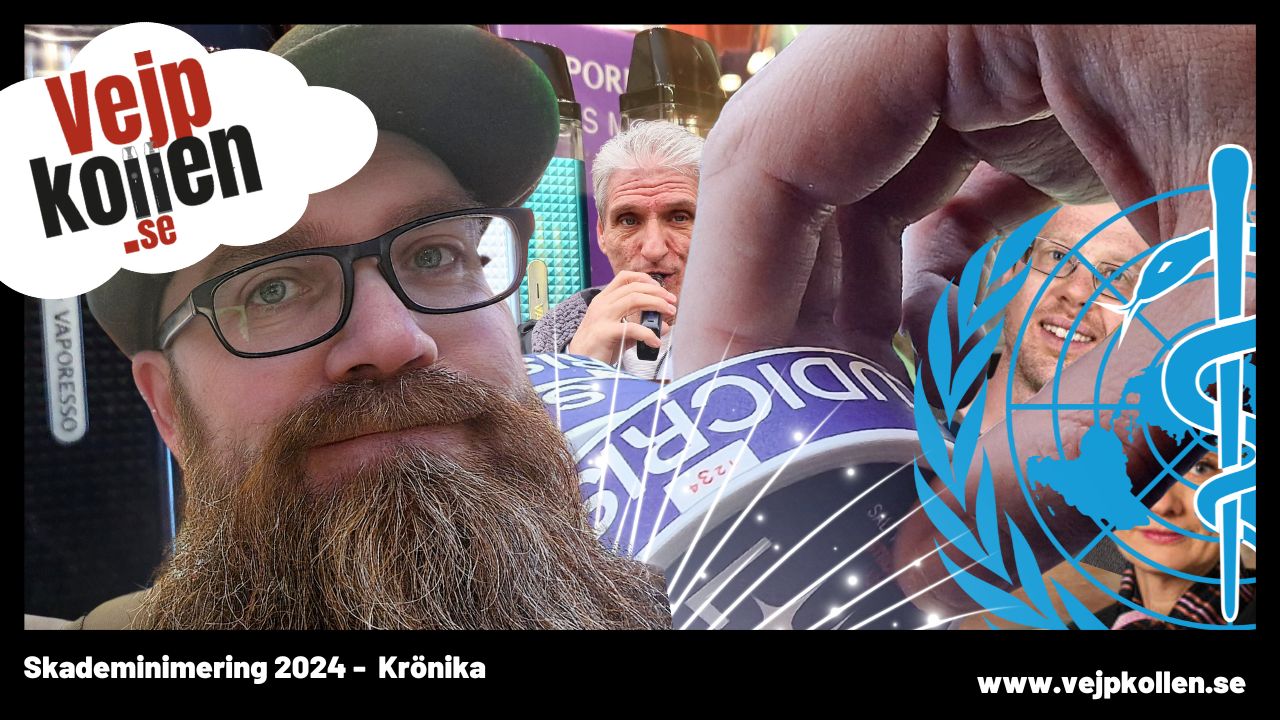Extreme prohibition policies in some countries, while surprisingly progressive decisions in others. This summarises the news year for Vejpkollen and harm minimisation reporting for smokers, 2023.
With the coming year and the Tobacco Convention meeting, it is becoming increasingly clear that the debate on new nicotine products will continue. And it is likely to be more about politics and less about science.
It is not a genuine concern about the risk of injury that is behind it prohibitions or restrictions the availability of nicotine pouches or flavours in e-cigarettes. Nor is it compliance with the tobacco industry behind measures such as favours smoke-free alternatives than the deadly cigarettes. The health risks of smokeless nicotine products are significantly less than they are for smoking and cigarettes. But that matters less.
Concerns among scientists
The issue of e-cigs, snus, nicotine and smoking has exposed a conflict that is rooted in everything from economics to ideology. This is also true in the scientific sphere. The issue is so infected that some researchers deliberately omit important parts of their studies just to 'avoid being in the wrong camp' or being perceived as 'bought by the tobacco industry'. A key issue for many researchers seems to be the 'stigma' that shines through when one's research may prove to be 'beneficial' to the sale of products that can generate income for tobacco companies, whether that was the intention or not.
'Don't want to favour the tobacco industry'
I recently asked the Swedish scientist Magnus Lundbäckwho in autumn 2023 published a high-profile study on e-cigarettes and cardiovascular health. In the ensuing media reports, he (or perhaps more accurately the headline writers) warned of the 'risks of e-cigarettes'. It was a small study that didn't really say much new about how nicotine affects users. The study got criticism in Vejpkollenmainly because of major flaws in the methodology, but also because the analysis only states that nicotine via e-cigarettes CAN be harmful, without comparing this with how harmful the use of nicotine actually IS in connection with smoking. I asked Magnus Lundbäck why his studies never compare the risks of vejping with the well-known risks of smoking. The answer came quickly.
"I have chosen not to get into that discussion at all, partly because it takes over too much of what I think is important. But it's also because I don't want to get caught up in something that would favour the launch of new nicotine products, something I basically don't think is a desirable development. Of course, I also read other studies and it is certainly possible to see differences between smoking and vejpa. E-cigarettes also seem to have some effect on smoking cessation, which is of course interesting. But in my research I see no reason to compare risks between e-cigarettes and smoking. That is for others to do." he said diplomatically during an interview for an upcoming article.
Tobacco companies' 'hidden' research
Fortunately, there are now many independent researchers and institutions that compare injury risks. For example, we have seen recurring compilations from The UK Public Health Agencyfood, US FDA and the Ministry of Health in New Zealand.
But also the tobacco companies producerare research which highlights the differences between smoking and vejpa. Because they have to. Some countries, such as the US, require robust research and auditable studies to even authorise the launch of the product. new nicotine products on the market. This process is costly and has affected many of the small and independent companies producing vejp products. However, the costs of randomised control trials, thousands of pages of toxicological studies and so on are not a major concern for the tobacco companies.
A hidden ban - that doesn't work
Not surprisingly, only 23 vejp products (out of millions) have been authorised for sale in the US. They are all produced by the tobacco companies and are only being launched with so called tobacco flavour. It is effectively a ban on all vejp products not sold by tobacco companies, according to many. At the same time, the 'ban' seems to have little effect.
"Although the FDA has effectively banned 99 per cent of all vejp products, it has no resources to control what is sold. We vejpers can still get what we need, often by simply asking for a particular flavour or e-liquid in the stores that remain. Many companies have switched to cannabis instead, but they usually have a stock of 'unauthorised' e-liquids behind the counter." Alex Clark noted, CEO for CASAa consumer association that organises over 250,000 American vejpers, when we met under E-cigarette summit in Washington in the spring.
WHO makes research 'untouchable'
Apart from a quirky implementation, the vejp technology (vaporisation of e-liquid) has been thoroughly reviewed by the US authorities. Flavouring is not the focal point when the FDA assesses the relative risks, the flavours are more about who is attracted to the products (read: minors). In principle, the vapour does not become more or less harmful because of the flavour. However, it is recognised that the products have characteristics that make them "appropriate for the protection of public health". In other words, the technology has clear harm-minimising effects on the nicotine market. The FDA has done the same in the assessment of the Swedish oral nicotine product - snus - a product that PMI can now promote as a "product that reduces the risks of nicotine use".
Unfortunately, few western institutions and authorities are taking the on this particular research. Not even those who take a favourable view of harm reduction in tobacco legislation. The reason is precisely The Tobacco Convention which makes any research coming from the tobacco companies untouchable.
"I just wish more researchers and policy makers would judge our research results by what they show, not where they come from. Test them, criticise them, refute them, but don't judge research by anything other than what the results show. Is that too much to ask?" said Ignacio Gonzalez Suarez, Director of Scientific Relations EU at Philip Morris International, when I met him at a of several conferences on harm reduction organised annually around the world.
Conflict with public health?
In the WHO Tobacco Convention, the authors emphasise the importance of keeping the interests of the tobacco industry at arm's length from health policy. This particular paragraph is therefore regularly used to exclude a not inconsiderable amount of knowledge about relative risks between different nicotine products. Although e-cigarettes, both the technology and the e-liquid, have little to do with the tobacco industry in the first place (it was small independent entrepreneurs who developed the products and created the market), the fact that the tobacco companies are now selling some of the products on the market is enough for the more aggressive anti-tobacco activists to be heard when they invoke the Tobacco Convention.
"The interests of tobacco companies are, by definition, always in conflict with public health," it has been said.
Ignoring 99.7 per cent of the research
The US has never signed the WHO Tobacco Convention, but Sweden has. And this can easily have absurd consequences. When the the Swedish government requested arescue that would put the harms (or estimated risks of harm) of different nicotine products side by side and give our health policy makers an evidence-based foundation for a modern ANDTS strategy, the Public Health Agency turned itself inside out to AVOID doing just that. Out of 6000 studies and summaries on the risks of vejping, the agency screened out all but 18. That is, it ignored looking at 99.7 per cent of the available research.
The report notes, of course, that "we don't know enough about e-cigarettes and vejping to say anything about the risks". A very marginal study with 12 participants from Karolinska institute (authored by Magnus Lundbäck), on the other hand, was used as a basis for the Public Health Agency's own statements on the issue.
"E-cigarettes affect blood vessels. All nicotine use is harmful. All should be regulated equally," said a statement. pressure cookersharing from the public health authority.
Regulatory activism?
Again, anything that could favour the tobacco industry MUST not affect health policy. In practice, it becomes government activism, where it is considered ok to not tell the whole truth as long as the message is "correct" and fits the anti-tobacco movement's, and thus the WHO's, narrative.
"Need to get the whole picture"
The report was naturally criticised. Not surprising since other authorities and institutions around the world seem to have had no problem whatsoever in finding evidence that vejpa is SIGNIFICANTLY less harmful than smoking. One can also make a fairly clear statement about the absolute health risks of vejpa, even though long-term studies are lacking.
'In all likelihood, the risks are small, although not non-existent', the UK Public Health Agency recently concluded in its annual knowledge report on vejpning in England.
The Swedish Public Health Agency did not even manage to show that there are clear differences between snusing and smoking. Or rather: you can read it between the lines when you look at the summary. But the agency never says it outright.
"My conclusion is that this report from FHM cannot be the sole basis for future decisions, but needs to be seen in a larger context. I would have hoped that more of the studies included in the report dealt with relative risk of injury, rather than prevalence. Here, we as decision-makers have to supplement with other studies to get a fair overall picture. For the Moderates, the overall goal is to reduce the habitual smoking of cigarettes, rather than to limit all use of nicotine." says Jesper Skalberg Karlsson (m), a member of the Social Affairs Committee, in a comment on the FHM report for an article in Vejpkollen.
Monitoring of the WHO is important
That said, 2024 will be an exciting year for those interested in the harm minimisation debate. Sweden has almost 1.2 million daily users of smokeless nicotine. Nearly one million of these are snus users, many of whom also use nicotine pouches and e-cigarettes. Vejpkollen will therefore follow the development closely, not least by monitoring COP10, the 10th meeting of the Tobacco Convention, taking place from 5 to 10 February in Panama. Here, delegates from around the world will decide whether or not snus, nicotine pouches and e-cigarettes should be regulated as cigarettes. At the moment, it looks like WHO wants to cut off access to EVERYTHING related to nicotine. How will Swedish delegates deal with this?
EU elections - a key issue for white snus?
The elections to the European Parliament will also open the debate on Swedish nicotine consumption, or perhaps rather our relationship with nicotine pouches, products that alongside e-cigarettes are likely to help reduce the harmful effects of smoking in Sweden. The EU Commission, like the WHO, wants to severely limit the possibility of using nicotine pouches, at the same time as restricting access to e-cigarettes, through everything from flavour bans, high taxes to subsidies for so-called "preventive measures" (where do you think Non Smoking Generation and Tobaksfakta get their money from?). Vejpkollen is of course monitoring the issue from a user perspective.
Interest is growing
Interest in the political game around nicotine is growing, which is not least reflected in the visitor statistics on Vejpkollen. An average of 5000 people a week visit the magazine. Add to this the enormous activity in the comment fields on social mediahe, where articles on the politics of snus, nicotine pouches and e-cigs are attracting a lot of interest. Vejpkollen's posts (direct links to articles) have been shared 2000 times in 2023. The posts have been commented on 4148 times and received 29455 reactions.
Why do it this way?
It is of course important that users understand how policy shapes the environment for alternative nicotine products. Many users e-cig, snus and nicotine pouches to keep non-smoking and quit nicotine addiction. At the same time, there are just as many people who just vejpake and snuff to they like the flavours, the social aspect, the kick and the feeling of using nicotine.
Hopefully, this commitment will continue and will also be picked up by politicians who can speak on their behalf in small and large contexts.




